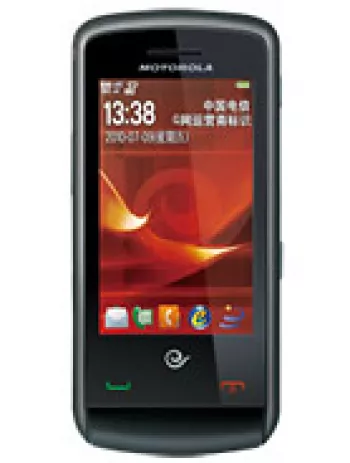
Overview of the Motorola W209
The Motorola W209 is a classically designed feature phone that was announced in 2007. It stands out as a compact and functional mobile device suitable for users who primarily desired basic communication functionalities. Despite being discontinued, its durable design and simplicity remain appealing to a niche audience who appreciate minimalist mobile technologies.
Network and Connectivity
Operating on GSM 900 and 1800 bands, the Motorola W209 is a 2G technologic device that was ideal for voice calls and text messaging. The lack of GPRS and EDGE support means it doesn't offer mobile data capabilities but this was common for feature phones at the time of its release. The focus was solely on efficient communication without the distractions of internet connectivity.
Design and Build
Physically, the W209 is compact, measuring 108 x 44 x 14.9 mm and weighing only 78 grams. This lightweight makes it a convenient option for users who prefer carrying their phone in pockets without feeling weighed down. With a sleek yet straightforward rectangular design, the phone was available in attractive red and silver color options. The use of a Mini-SIM reflects the technological norms of the time and allowed easy swapping between networks.
Display Characteristics
The display of the W209 is a modest 1.6-inch TFT screen capable of showing 65,000 colors with a resolution of 128 x 128 pixels. While modern users might scoff at such a specification, proper context reveals that this was more than sufficient for navigating menus and viewing simple graphics during its release period. The small screen size and basic resolution keep battery consumption low, conserving energy for prolonged usage.
Memory and Storage
Given that the Motorola W209 is a feature phone, its memory and storage capabilities are expectedly limited. The device does not support external memory cards but maintains a sufficient phonebook capacity, storing up to 500 contacts — a substantial amount for typical use. Call records can store logs of 10 dialed, received, and missed calls, ensuring users could easily manage their communication history without overwhelming the phone's storage.
Sound and Audio Features
Sound functions on the W209 include a built-in loudspeaker for clearer audio during calls and polyphonic ringtones alongside vibration alert options. However, one of its limitations is the absence of a 3.5mm headphone jack, meaning users would rely on the internal speaker and pre-installed melodies.
Communication Options
Communication was straightforward with the Motorola W209. The phone does not feature Bluetooth or WLAN, underscoring its basic nature. Nonetheless, it offers an integrated FM radio, providing users with entertainment and information on the go without the need for data services.
Additional Features
As a classic feature phone, the W209 includes basic features such as the ability to send and receive SMS messages, and it comes with pre-installed games for casual entertainment. The absence of a browser and Java support limits its functionality, focusing solely on core communication tasks. This simplicity is appreciated by users looking to disconnect from the constant demands of modern smartphones.
Battery and Power Management
The battery life of the W209 is robust, aided by its removable Li-Ion battery which offers users a standby time of up to 310 hours and a talk time of approximately 7 hours and 30 minutes. This extended battery life is facilitated by the phone's minimalist features and low energy consumption display, providing users with reliability for days on end without needing frequent recharges.
Price and Market Position
When it was available, the Motorola W209 was an affordable option, priced around 50 Euros. Its market positioning was geared toward individuals looking for reliability and essential functionalities without the need to invest in high-cost devices.
Conclusion and Legacy
Although surpassed by more feature-rich and internet-driven smartphones of later years, the Motorola W209 remains a noteworthy example of early mobile technology. Its design philosophy and functionality catered to users prioritizing straightforward communication, paving the way for the durable, long-lasting feature phone design ethos. As technological desires evolve, devices like the W209 are fondly remembered for their simplicity and reliability.
Key Features of Motorola W209
- Lightweight Design: Weighs only 78 g (2.75 oz)
- Compact Size: Dimensions of 108 x 44 x 14.9 mm, 65 cc
- Durable Display: 1.6 inches TFT screen with 65K colors
- FM Radio: Built-in FM radio for music and news
- Long Battery Life: Up to 310 hours stand-by time and up to 7 hours 30 minutes talk time
- Affordable Price: Approximately 50 EUR
- Color Options: Available in Red and Silver
Disadvantages of Motorola W209
- No GPRS or EDGE support for internet connectivity.
- Lacks a camera, which is a common feature in modern phones.
- No Bluetooth functionality for wireless connectivity.
- Limited display with only 65K colors and low resolution.
- No expandable memory card slot for additional storage.
- Does not have a 3.5mm headphone jack.
- No WLAN capability for wireless internet access.
- No USB connectivity for transferring data.
- No positioning capabilities like GPS.
- Basic messaging limited to SMS without email or MMS support.
- No web browsing capabilities.
- Limited call logs capacity, holding only 10 records for each category.

View Also
More Phones
All Rights Reserved +14266 Phones © Mobilawy 2025

























